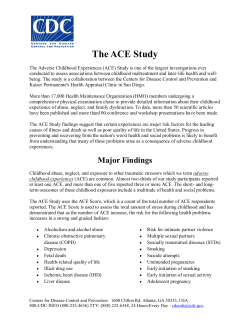
ACE kinetic Clinical Applications in Routine and Research
ACE kinetic Clinical Applications in Routine and Research CE-marked Settings for Clinical Chemistry Analysers ACE-Monitoring is contributory to diagnose Sarcoidosis ACE-Monitoring of Sarcoidosis allows therapy adjustments ACE-Monitoring of hypertensive patients allows surveillance of treatment efficacy Genotype-corrected normal ranges increase the clinical sensitivity of ACE activity ACE-Monitoring allows therapy adjustments of patients under nephroprotective ACE-inhibitor therapy CF025-04ML -E Medical Background ACE ACE Skin/Skeleton 25 In vivo, Angiotensin-Converting Enzyme (ACE) catalyses the conversion of Angiotensin I to Angiotensin II and inactivates bradykinin during regulating blood pressure via Renin-Angiotensin-System. Heart 5 Elevated levels of serum ACE associated with the ACE-I/D-gene polymorphism have been measured in patients suffering from various disorders. They often indicate a poor prognosis or rapid progression of the disease. • Granulomatous-inflammatory dis eases such as Sarcoidosis and MixedConnective-Tissue Disease (MTCD)*9 • Nephropathies associated with Diabetes and Glomerulonephritis*10,12 • Cardiovascular diseases such as left ventricular hypertrophy, brain and myocardial infarction*12 Sarcoidosis Sarcoidosis is an inflammatory disease of unknown origin characterised by the formation of granuloma. The prevalence of this multisystem granulomatous disorder, which activates the immune system, varies between ethnic groups and geographic regions. Worldwide, the incidence of Sarcoidosis ranges from 10-80 cases per 100.000 inhabitants. The average age at onset is between 20 and 40 years in both men and women. Sarcoidosis may occur as acute or chronic form. The onset of the chronic type is slowly and without clear symptoms. In about 20% of the cases especially multi-organ involvement may become lifethreatening. The main symptoms are: enlargement of lymph nodes, fever, chest pain and cough and painful nodules under the skin. Symptoms may be associated with a specific organ or with several organs*5: Organ Patients % Lymph nodes 90 Lung 90 Liver Eyes (Uveitis) 60–90 25 Diagnosis Sarcoidosis patients exhibit no distinct clinical signs. Therefore, Sarcoidosis remains a diagnosis of exclusion. In this context, the measurement of ACE may contribute to confirm Sarcoidosis. The following critieria for the diagnosis of Sarcoidosis have been established: Identification of the typical clinical and/ or radiologic picture closely related to Sarcoidosis, mainly supported by the non-case-ating granulomas and exclusion of all other sarcoidosis-like diseases. Diagnosis is supported by bronchoalveolic lavage which indicates a proliferation of T-Lymphocytes and a shift of the CD4/ CD8 composition towards CD4-cells. Monitoring disease activity Monitoring of disease activity is essential to predict disease progression. A clinical investigation, the assessment of lung capacity and a radiologic examination are routinely performed. Spontaneous and therapy-induced changes of the inflammatory activity predicting a deterioration are reflected better by serum parameters such as sIL-2R, neopterin and especially ACE activity in serum. Therapy options In most cases of acute Sarcoidosis the administration of NSAIDs is sufficient. In cases of chronic-progressive courses a therapy with corticosteroids is recommended. According to the severity of the disease and the response to the drug an initial dose is established and gradually reduced later on. A life-long treatment with a low dose of corticosteroids may be necessary. In cases of corticoid-resistance an immunosuppressive therapy using combinations of Cyclosporine A, Azathioprine, Methotrexate or Cyclophosphate are being used. Monitoring disease activity of Sarcoidosis with ACE The chronic forms can last several years or even a life time. Consequently, diagnostic tools are essential to closely monitor the disease activity and to predict disease progression. ACE is valuable to assess the disease activity, especially in systemic Sarcoidosis. It is released by epitheloid cells and its serum level correlates significantly with the granuloma burden of the patient. The positive predictive value of elevated ACE activity is estimated between 7590%, the negative predicted value between 70-80%*17. An initial low ACE activity indicates a good prognosis. Elevated levels significantly correlate with the grnuloma burden of the individual. If only one organ is affected ACE activity often shows values within the normal range. Examples of individual chronic disease courses are presented below (Case 1 and 2). Important: An increase in ACE activity within the normal range may indicate a disease progression. Genotyping A deletion-/insertion- polymorphism in intron 16 of the angiotensin-converting enzyme (ACE) gene located on chromosome 17 has been detected. A sequence of 287 base pairs is either present (insertion, I-allele) or absent (deletion, D-allele). Studies of the D/I-polymorphism have shown the D-allele to be associated with an enhanced ACE activity, and the I-allele with a lower one. The assessment of the gene polymorphism and the establishment of genotype-corrected values is thus help-ful to improve the clinical value of ACE. It has been shown that ACE genotyping and genotype-corrected reference ranges have improved the clinical sensitivity of ACE activity in Sarcoidosis, which is still the main application of ACE in serum *1. Other Areas of application Chronic Berylliosis Berylliosis is induced by Berylliumoxid exposure at the work place. The clinical picture and symptoms are identical to what is reported with Sarcoidosis and has to be excluded in order to diagnose correctly*5. Differential diagnosis can be made if a skin test is used. Areas of Application Disease Monitoring with ACE activity – examples Therapy monitoring is performed according to the disease activity in intervalls between 3 months and one year. Examples for typical therapy follow-up under therapy with Prednisolone: 90 1 08.08.06 without Pred. ACE 33,1U/l 80 20 A variety of diseases is associated with chronic progressive renal failure. ACE-I/D-Polymorphism is used as a prognostic marker of disease progression. The DD- and the ID-genotype benefit from a therapy with ACE inhibitors*9. The efficacy of ACE inhibitors and thus the individual need of drugs can be determined using ACE activity testing. The treatment with ACE inhibitors is most effective in the following diseases. 4 10 2 3 5 7 20 0 03 . 15 . 08 . 03 . 08 . 07 . 20 0 20 0 6 6 6 20 0 30 . 29 . 03 . 12 . 06 . 20 0 20 0 5 5 0 09 . The value of the ACE-I/D-polymorphism as a prognostic marker of disease progression is discussed controversially. Some groups use ACE activity measurements for therapy monitoring under ACE inhibitors*10. Nephroprotection under ACE inhibitor therapy 10.11.06 5mg Pred. ACE6U/l 30 03.07.06 without Pred. ACE 16,5U/l 30.03.06 without Pred. ACE 11,8U/l 40 29.12.05 Pred.-Dosis 2,5 mg 50 09.06.05 Start: 45mg Pred. ACE 63,9U/l ACE U/L 60 ACE78,6U/l 70 Monitoring of Cardiovasculardiseases/ Hypertension • Diabetes mellitus ACE inhibitors show nephroprotective action. Further more, ACE activity can be elevated in cases of proliferative Retinopathy*7. • Focal and segmental Glomerulo sclerosis, IgA Nephropathy Patients with DD- and ID-genotype are treated with ACE inhibitors to reduce the risk of renal failure. The efficacy of ACE inhibtors is assessed by measuring ACE activity*9. Case 1 60-year old patient with ACE I/D-Gene Polymorphism: Genotyp ID under therapy with Prednisolone. Prednisolone and Delix (ACE-inhibitor, contains Ramipril). Follow-Up: 1. Prednisolone-reduction; 2. Prednisolone discontinued; 3. without Prednisolone; 4. without Prednisolone; 5. Prednisolone-restart 24.11.06 5mg Pred. ACE 13,6U/l ACE16,1U/l 5mg Pred. 04.05.05 12.12.05 15mg Pred. 06 ACE 13,6U/l .2 0 05 • Many patients are at risk of developing pulmonary hypertension, which is indicated by incresing levels of ACE activity*8. Summary .0 3 01 .0 3 Mixed-Connective-Tissue Disease 10 8 .2 0 .2 0 .0 3 01 .0 3 01 5 04 03 .2 0 02 .2 0 .0 3 4 01 ACE 73U/l 3 03.12.04 7,5mg Pred. 2 0 01 01.08.04 15mg Pred. ACE18U/l 20 01.04.04 10mg Pred. ACE6U/l 40 27.05.02 without Pred. ACE U/L 60 23.07.03 50mg Pred. ACE 80U/l 1 80 ACE 13,8U/l 100 Case 2 41year-old patient with ACE I/D-Gene Polymorphism: Genotype II. Long-term treatment with a low dosis of prednisolone. ACE levels have been classified as elevated only by using genotype-corrected normal ranges. Follow-Up: 1. Without Prednisolone ; 2. Prednisolone-increase; 3. Pred.-reduction; 4. Pred.-increase; 5. Pred.-reduction; 7. Pred.-increase; 8. Pred. reduction; 9. low Dose These data have been provided by Professor Dr. med J. Müller-Quernheim, University of Freiburg, Germany Serum ACE is a highly specific marker for the disease activity monitoring of Sarcoidosis patients. Genotype-corrected normal ranges should be used to increase the clinical sensitivity of the parameter. Serum ACE is a valuable marker for efficacy monitoring of ACE inhibitor therapy in diseases associated with ACE-I/DGene-Polymorphism. Genotype-corrected reference values for serum ACE Adults Normal Ranges Children Genotype corrected reference values using ACE kinetic have been established by Prof. Müller-Quernheim, University Clinic of Freiburg, Germany*1 . Serum levels in children are substantially higher and more variable than in adults. No differences have been observed related to age and gender. ACE activity levels in newborns are very low. 84 children were included in the evaluation of normal ranges. Mean 2SD-Range Age Median 2.5-97.5th U/L U/L years U/L Percentile U/L DD-Genotype 59.3 30.1 - 89.5 0,5 - 18 66.9 29.3 - 112.2 DI-Genotype 45.5 15.1 - 75.9 II-Genotype 34.8 7.4 - 62.2 Total 47.0 12.4 - 81.6 Sarcoidoses Other Applications 1 Biller et al.: Genotype-corrected 7 Müller-Quernheim J. et al.: Diagnosis reference values for serum angiotensin-converting enzyme. Eur Respir 2006; 28: 1065 -1090 of chronic beryllium disease within 2 Brause et al.: Renal involvement in 8 Barnas et al.: Evaluation of risk sarcoidosis - a report of 6 cases. Clin Nehrol. 2002 Feb; 57 (2): 142148 factors for the development of nephropathy in patients with IDDM: Insertion deletion angiotensin- converting enzyme gene polymorphism, hypertension and metabolic control. Diabetologia, 1999; 40: 327-321 cohorts of sarcoidosis patients. Eur resp. J. 2006; 27(6):1190-5 3 Muller B.: Analysis of serum angio- tensin-converting enzyme. Ann Clin Biochem 2002; 39: 436-443 4 Costabel U. and Hunninghake GW: ATS/ERS/WASDOG statement on sarcoidosis. Sarcoidosis Statement Committee. American Thoracic Society. European Respiratory Society. World Association for sarcoidosis and other Granulomatuous Disorders. Eur Resp J., 1999; 14: 735737 9 Ozawa T. et al.: Increased serum angiotensin-converting enzyme in patients with mixed connective tissue disease and pulmonary hypertension. Scand. Rheumatol 1995; 24: 38-43 10 Luther Y. et al.: Effects of the gene- tic polymorphism of the angiotensin system on focal segmental glomerulosclerosis. Kidney Blood Press Res. 2003; 26(5-6):333-7 5 Studdy P.R. and Bird R.: Serum angi- otensin-converting enzyme in Sarcoidosis – its value in present clinical practice. Ann Clin Biochem 26, 13-18 (1990) BÜHLMANN Laboratories AG Baselstrasse 55 CH – 4124 Schönenbuch /Basel Switzerland 13 Ronca-Testoni S.: Direct spectrophotometric assay for angiotensin-converting enzyme in serum. Clin Chem 29, 1093-1096 (1983) 14 Bénéteau B. and Baudin B. et al.: Automated kinetic assay of angiotensin-converting enzyme in serum Clin Chem 32, 884-886 (1986) 15 Lieberman J.: Elevation of serum angiotensin-converting enzyme (ACE) level in Sarcoidosis. Am J Med 59, 36-72 (1975) 16 Hurst P.L. and Lovell-Smith C.J.: Optimized assay for serum angiotensin-converting enzyme activity. Clin Chem 27, 2048-2052 (1981) 17 L.Thomas: Labor und Diagnose; TH Books Verlag; 2000: 53-56 11 Fraser: Serum angiotensin-conver- ting enzyme assays should be ubiquitously available. Ann Clin Biochem 2003; 40: 194-197 6 Müller-Quernheim J. eds: Interstiti- elle Lungenerkrankungen. Standards in Klinik, Diagnostik und Therapie; page 57 ff; Thieme Verlag Stuttgart - New York Methodical Background 12 Phone +41 61 487 12 12 Fax orders+41 61 487 12 99 info@buhlmannlabs.ch www.buhlmannlabs.ch Butler, R.: The DD-ACE genotype and cardiovascular disease; Pharmakogenomics (2000 1(2): 153157 Ordering code: KK-ACK 100 Tests KK-ACK2 2 x 50 Tests KK-ACK4 400 Tests KK-ACKX 1200 Tests KK-ACF 130 Tests Related products: KK-CYC KK-CYC-6
© Copyright 2025





















